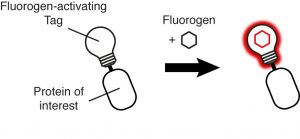Fluorescence imaging has become and invaluable tool in cell and molecular biology. There are different methods by which a protein of interest can be fluorescently labeled. The first involves autofluorescent proteins such as GFP or mCherry. Another approach makes use of a protein tag (or fluorogen-activating tag) linked to the protein of interest and incorporation of an external chromophore (or fluorogen, see figure below). In their review published in BioEssays, Arnaud Gautier and Alison Tebo discuss these fluorogenic protein-based strategies and how they can be employed for detection, actuation and sensing.

General concept of fluorogen-based reporters.
One advantage of this system is that the fluorogen usually exhibits little to no fluorescence when it is not bound to its receptor. Furthermore, systems have been developed that make use of naturally occurring chromophores – such as flavin mononucleotide (FMN), biliverdin or bilirubin – eliminating the need for exogenous application of the fluorogen.
In addition, the chromophore may be linked either covalently or noncovalently and this influences the type of biological imaging that can be envisaged. Moreover, these fluorogenic systems also allow imaging in the near-infrared which is impossible with classic autofluorescent systems. And finally, systems employing flavin-binding proteins were shown to work well under hypoxic conditions, another limitation of autofluorescent systems.
In addition to providing the advantages described above with regards to labeling, fluorogenic protein systems can also be used for the specific subcellular generation of reactive oxygen species, e.g. singlet oxygen. Additionally, this system employing miniSOG (for mini singlet oxygen generator) can also be used for targeted killing of cells and for light inactivation of proteins.
Another application of fluorogenic protein systems is their use as biosensors to detect intracellular events. Monitoring protease activity and the detection of protein-protein interactions are just two examples of what has already been achieved in this regard.
With their broad spectrum of various applications from labeling to actuation and sensing, these fluorogenic protein systems will provide a versatile tool to help answer outstanding questions in cell and molecular biology.

















